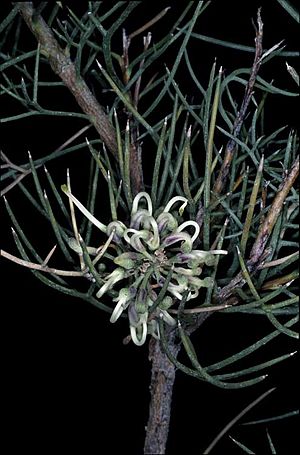Hakea pulvinifera facts for kids
Quick facts for kids Hakea pulvinifera |
|
|---|---|
 |
|
| A Hakea pulvinifera plant in the ANBG | |
| Conservation status | |
| Scientific classification | |
| Genus: |
Hakea
|
| Species: |
pulvinifera
|
Hakea pulvinifera is a rare and prickly shrub that belongs to the plant family Proteaceae. It grows only on one rocky hillside near Gunnedah in New South Wales, Australia. This plant has a very interesting history: it was first officially described in 1962, then thought to be extinct in 1971, but luckily, it was found again in 1988! Scientists believe that all the Hakea pulvinifera plants alive today might actually be part of just one single plant, making it incredibly unique.
Contents
What Does Hakea pulvinifera Look Like?
This shrub can grow up to about 4 metres (13 feet) tall. It has thick bark that looks like it's made of many small, flat pieces fitted together.
Its leaves are about 10 centimetres (4 inches) long. Each leaf is divided into several smaller parts, which are 2 to 4 centimetres (0.8 to 1.6 inches) long and about 2 millimetres (0.08 inches) wide. Each of these leaf parts ends in a sharp, pointy tip.
The flowers of Hakea pulvinifera grow in groups of 40 to 50. They are creamy-white and green and appear where the leaves join the stem. This plant usually flowers from September to November.
How Hakea pulvinifera Reproduces
Even though Hakea pulvinifera produces flowers, its pollen grains are shrivelled and empty. This means the plant cannot make seeds in the usual way. Scientists have never seen any fruit on these plants either.
Instead of growing from seeds, Hakea pulvinifera likely reproduces by sending out new shoots from its roots. These new shoots, called suckers, grow up from under the ground, creating new plants that are genetically identical to the parent plant.
Discovery and Naming of Hakea pulvinifera
This special plant was first discovered in 1949, but it wasn't officially named until 1962. An Australian botanist named Lawrence Alexander Sidney Johnson gave it its scientific name.
The name pulvinifera comes from two Latin words: pulvinus, meaning "cushion" or "pillow", and fero, meaning "to bear" or "to carry". This name refers to a small swelling that looks like a cushion at the base of the plant's leaves.
The Plant That Was Lost and Found Again
After its discovery, scientists visited the plant population again in 1966 to gather more information. However, when they went back in 1971, they couldn't find the plants. It was thought that the original group of plants might have been destroyed when a car park was built. For a while, people believed Hakea pulvinifera was extinct.
But in 1988, a park ranger named S.P. Morrison "rediscovered" the plant! He used Lawrence Johnson's original notes from 1962 to find a small group of these plants on a steep hillside. This new location was very similar to where the plant was first found. Scientists later confirmed that this was almost certainly the same population that had been seen before.
Where Hakea pulvinifera Lives
Hakea pulvinifera is a very rare plant. It is only found in a small area in the Northern Tablelands region of New South Wales. It prefers to grow on steep, rocky slopes that don't have much soil.
Protecting Hakea pulvinifera
Because Hakea pulvinifera is so rare and only found in one small spot, it is classified as "endangered." This means it is at a high risk of disappearing forever. Both the Australian Government and the New South Wales Government have laws to protect this plant. A special plan has been created to help save and recover this unique species.
Images for kids



